上一篇讨论了视图状态的用法,让我们再回到第八篇的时候.从第八篇的时候跳了很大篇幅来继续讲属性,然后接着讲类型转换器,再接着讲视图状态.绕到现在才接着讲复合控件的样式的使用,因为上面讲的东西是紧密联系的.如果已经理解自定义视图状态管理,那这一篇则看起来相关的简单.
ASP.NET控件开发基础之为子控件添加样式1.复合控件中样式属性概述
在第六篇的时候已经介绍过样式的使用了,在复合控件中你同样可以用此方法给控件定义多个样式属性,但此方法很适合像label这样非复合控件.
当然复合控件可以适当的定义其自身的样式属性,同时你还需要为其子控件提供样式,典型的控件如GridView控件,如下图

它有很多不同种类的列,而每种不同的列则有不同的样式集合属性,如果将其每个样式属性均暴露为***属性,那样式属性将变得很混乱.
我们可以用此方法为复合控件的子控件定义样式,实现每个子控件对应Style类型的复杂样式属性,将样式属性暴露为复合控件的***属性,这样更容易管理复合控件样式属性.
ASP.NET控件开发基础之为子控件添加样式2.复合控件中样式属性实现(为子控件提供样式)
Style类本身继承IStateManager 接口,并实现了接口方法.在第五篇我们曾重写CreateControlStyle方法,如下
- protected override Style CreateControlStyle()
- {
- return new Style(ViewState);
- }
其初始化的时候即存储样式信息在视图状态中,而其自定义的样式的状态管理机制则跟上一篇非常的相似.你需要重写Control类的状态管理的几个方法来实现样式的状态管理.还是以登录控件为例.
(1)先自定义样式集合属性
定义方法跟上一篇视图状态中的Address属性很相似
如下代码
- #region 样式属性
- [
- Category("Styles"),
- DefaultValue(null),
- DesignerSerializationVisibility(
- DesignerSerializationVisibility.Content),
- PersistenceMode(PersistenceMode.InnerProperty),
- Description(
- "应用于按钮的样式")
- ]
- public virtual Style ButtonStyle
- {
- get
- {
- if (_buttonStyle == null)
- {
- _buttonStyle = new Style();
- if (IsTrackingViewState)
- {
- ((IStateManager)_buttonStyle).TrackViewState();
- }
- }
- return _buttonStyle;
- }
- }
- [
- Category("Styles"),
- DefaultValue(null),
- DesignerSerializationVisibility(
- DesignerSerializationVisibility.Content),
- PersistenceMode(PersistenceMode.InnerProperty),
- Description(
- "应用于文本框的样式")
- ]
- public virtual Style TextBoxStyle
- {
- get
- {
- if (_textBoxStyle == null)
- {
- _textBoxStyle = new Style();
- if (IsTrackingViewState)
- {
- ((IStateManager)_textBoxStyle).TrackViewState();
- }
- }
- return _textBoxStyle;
- }
- }
- #endregion
(2)自定义视图状态管理
因为此处定义了两个样式集合属性,所以用到了Triplet这个辅助类,其跟Pair类一样都是辅助类,而其可以存储三个相关对象的基本结构.如果你要储存三个以上就不能用这两个辅助类了,实现方法还是很简单的.
如下代码
- #region 自定义视图状态
- protected override void LoadViewState(object savedState)
- {
- if (savedState == null)
- {
- base.LoadViewState(null);
- return;
- }
- else
- {
- Triplet t = savedState as Triplet;
- if (t != null)
- {
- base.LoadViewState(t.First);
- if ((t.Second) != null)
- {
- ((IStateManager)ButtonStyle).LoadViewState(t.Second);
- }
- if ((t.Third) != null)
- {
- ((IStateManager)TextBoxStyle).LoadViewState(t.Third);
- }
- }
- else
- {
- throw new ArgumentException("Invalid view state .");
- }
- }
- }
- protected override object SaveViewState()
- {
- object baseState = base.SaveViewState();
- object buttonStyleState = null;
- object textBoxStyleState = null;
- if (_buttonStyle != null)
- {
- buttonStyleState =
- ((IStateManager)_buttonStyle).SaveViewState();
- }
- if (_textBoxStyle != null)
- {
- textBoxStyleState =
- ((IStateManager)_textBoxStyle).SaveViewState();
- }
- return new Triplet(baseState,
- buttonStyleState, textBoxStyleState);
- }
- protected override void TrackViewState()
- {
- base.TrackViewState();
- if (_buttonStyle != null)
- {
- ((IStateManager)_buttonStyle).TrackViewState();
- }
- if (_textBoxStyle != null)
- {
- ((IStateManager)_textBoxStyle).TrackViewState();
- }
- }
- #endregion
(3)为子控件添加样式集合属性
上面工作做好后,然后你就可以在呈现方法Render方法或RenderContent方法中为子控件添加样式集合属性,如下代码
- if (_buttonStyle != null)
- {
- submitButton.ApplyStyle(ButtonStyle);
- }
- if (_textBoxStyle != null)
- {
- nameTextBox.ApplyStyle(TextBoxStyle);
- emailTextBox.ApplyStyle(TextBoxStyle);
- }
来看一下效果,属性面板已经有子控件样式集合属性了,这样就更容易管理样式了.

定义子控件样式就这么的简单,主要难点还是在于自定义视图状态管理,对自定义视图状态管理熟悉的话,看到这里肯定很简单,如果没看明白就须先弄懂如何自定义视图状态管理.
注意点:ASP.NET中复合控件可以直接继承CompositeControl类即可,大家可以了解一下此类。
ASP.NET控件开发基础之为子控件添加样式的基本情况就向你介绍到这里,希望你对ASP.NET控件开发基础之为子控件添加样式有所了解。
【编辑推荐】
























